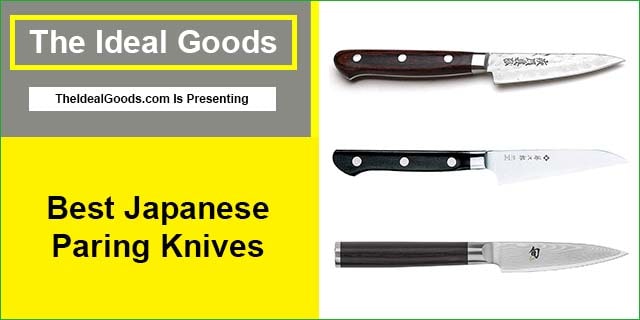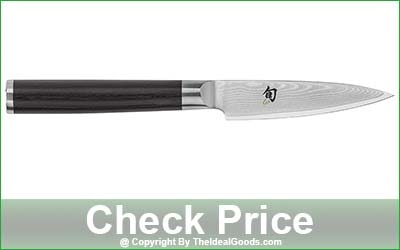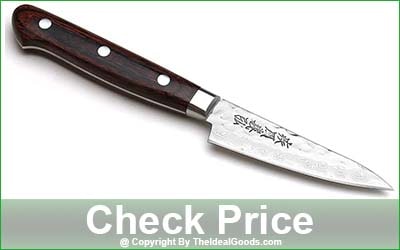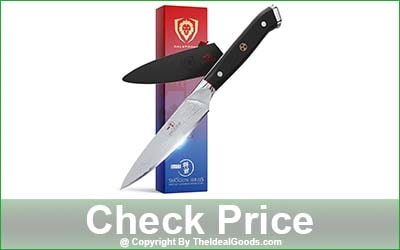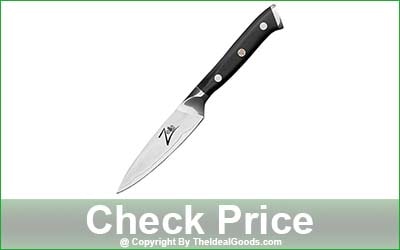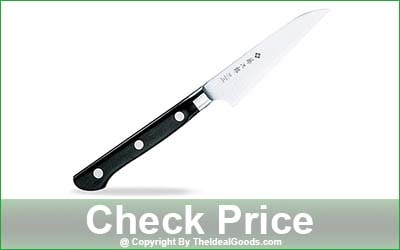Read this well-researched article if you don’t want to buy fake Japanese paring knives that are made from cheap low-quality steel or Chinese steel. All the knives I have selected here are from well-known manufacturers who have a long history of providing the highest level of satisfaction to hundreds of customers. Most importantly, every paring knife recommended here has been reviewed through use and testing.
I looked into 30-40 knives while compiling this list of original Japanese paring knives, and then I chose these knives based on a set of criteria. Here are some of the key criteria-
- Genuine Japanese steel of the highest quality is used to make each knife.
- Each knife has a full tang and is perfectly balanced.
- The handle is non-slip, ergonomic, and comfortable to hold.
- Of course, each knife is backed by a strong lifetime warranty.
What’s the Best Japanese Paring Knife?
| Product | Best For |
|---|---|
| 1. SHUN – 3.5″ VG-MAX 69-Layer Japanese Paring Knife | Best-Selling |
| 2. YOSHIHIRO – 3.2” VG-10 16-Layer Japanese Paring Knife | Premium-Quality |
| 3. DALSTRONG – 3.5″ AUS-10V 67-layer Japanese Paring Knife | Top-Rated |
| 4. ZELITE INFINITY – 4″ AUS-10 67-Layer Japanese Paring Knife | Most-Affordable |
| 5. TOJIRO DP – 3.5″ VG-10 Japanese Paring Knife | Best-Overall |
Best Japanese Paring Knife
1. Shun Cutlery Classic Japanese Paring Knife – DM0700
If you are a serious home cook or professional chef and looking for a pure Japanese peeling knife that is masterfully designed and crafted in Japanese style then who better than Shun?
Its 3.5″ long blade is made of 69 layers of Damascus steel whose core is Japanese premium steel VG-MAX (HRC: 60-61) and the core is wrapped with 34+34 total of 68 folds of soft high-carbon stainless steel.
I’ve used the knife to cut a variety of food items effortlessly for a variety of tasks, such as peeling and slicing fruits and vegetables, trimming meats, and creating intricate garnishes. Its balance, overall size (8′′), and exceptional performance make the knife highly agile for delicate dicing chores.
The Damascus cladding on the blade gives the knife a unique and distinctive look. Because of the layers, food ingredients have not crashed, were damaged, or were not stuck during cutting.
The Pakkawood handle is also well-shaped and moisture-resistant. Its classy-looking D shape design is ergonomic and comfortable to hold. The lovely wood handle feels warmer, grippy, aesthetically pleasing, and easy to handle.
Additionally, the handle has a smooth rounded choil where I can ergonomically place my index finger, which provides excellent control and precision as well as maximum user safety in cutting.
The knife is a little bit heavier but considerably more sturdy and balanced thanks to the full tang structure with polished bolster and end cap.
Pros
- It arrived extremely sharp straight out of the box
- Thin blade seamlessly cuts almost all ingredients precisely
- Holds an edge really well and is easy to sharpen
- The handle fits nicely in my large hands
- Handle is water/bacteria-proof & highly resistant to moisture
- Shun Damascus paring knife is handcrafted in Seki City, Japan
- This knife comes in the warranty is lifetime
Cons
- High-end knife but there is no sheath
- The handle is also relatively thin
2. Yoshihiro Japanese Damascus Paring Knife – HDPE80
The 3.2″ long full tang blade of this knife is made from high-end Japanese 17-layer Damascus stainless steel. The core of the blade is VG-10 super steel (HRC: 60+) and both sides of the core have 8+8 stainless steel cladding for a total of 16 layers.
The blade was scalpel-like sharp right sharp out of the box. However, I am more than surprised by its edge retention capacity because after two months of mincing, peeling, trimming, and slicing vegetables and fruits almost every day with the knife, I did not find any changes in its sharpness.
The belly of the knife is slightly wider and the front is gently curved so the overall geometry of the blade guided me as I tried to thinly slice the food. It was like a whole new experience for me in peeling work.
A good feature of premium-grade Japanese steel is that it takes an instant razor-sharp edge when sharpened with a good quality water stone.
The mahogany wood handle is the western style which makes it easy to hold for a long time to perform delicate tasks. The handle feels smooth, comfortable, and non-slip.
The fittings have no gaps or sharp edges between the wood, bolster, and triple rivets. The joints of every part of the handle are perfect and polished; no annoying uneven corners or surfaces anywhere.
This choil is the right size and positioned at the perfect distance from the bolster so it gives me better control while doing delicate work quickly. Although the choil of the handle is not round, I did not feel any fatigue or soreness when I kept the index finger on for a long period of time. It also prevents my fingers from slipping and touching sharp edges.
Pros
- Outstanding stain and corrosion resistance
- Easy to sharpen and holds an edge like the best of all
- Damascus and hammered patterns prevent food from sticking
- Attractive combination of dark handle and shiny blade
- Handle feels solid, well balanced, and easy to hold to do detailed work
- Handcrafted in a traditional style by Japanese master artisans
- The knife is covered by a limited lifetime warranty
- Absolutely a premium quality knife, well worth the money
Cons
- Didn’t get any protective sheath with the knife
- No more cons against this knife
3. Dalstrong Damascus Paring Knife – Shogun Series Elite
This paring knife has a 3.5” long and 1.5mm thick 67-layer Damascus steel blade. Dalstrong uses Japanese premium steel AUS-10V (HRC: 62+) for the core of the blade and is folded with gorgeous layers of 33+33 total of 66 high-carbon stainless steel to protect and support the core.
The forged blade goes through Dalstrong’s special nitrogen-cooled and precisely vacuum-treated processing. Through this method, the durability, toughness, edge retention, and wear resistance of the blade are increased much more than in normal conditions. The sharpness of the blade is so great that I feel like I’m cutting butter with a hot knife when cutting fruits and vegetables.
After using the knife almost daily for the first three months, I found the blade to be as sharp as day one which proves that the blade is truly made from superior steel. The blade had lost some of its sharpness after about five months of use, and I brought the knife back to the factory edge (8-12°) in just a few minutes of sharpening on a whetstone.
The triple-riveted handle is made of military-grade G10. Being heat, moisture, and water proof, the handle is easy to maintain and ensures long-lasting durability.
The full tang handle is a perfect size and gives a comfortable and good grip as well as a hefty feel. Besides, the finish of the pairs of scales, tang, rivets, bolster, and end-cap is highly polished and smooth.
The western-style handle is easy to hold and quick to maneuver. I got a good balance between the weight of the handle and the blade, so I didn’t feel any fatigue in my hands even after working for a long time.
The company has provided a plastic sheath of its own making to store the knife. The black sheath is quite good quality and sturdy. The sheath has a small button that helps hold the knife in place and also has a lanyard hole for hanging.
Pros
- The blade came super sharp right out of the box
- Highly resistant to rust, requires very low maintenance
- Food ingredients do not stick when cutting
- Full tang handle is solid, comfortable, and well-balanced
- Handle fits my XL sized hands, non-slip, yet not tacky
- It comes with a pin, sheath, polishing cloth, and honing instructions
- Full refund guarantee & lifetime warranty against defect
Cons
- None so far, really nice knife
4. Zelite Infinity Japanese Paring Knife – Alpha Royal
Imported Japanese AUS-10 premium steel (HRC: 60-61) is used for the blade core and the core is protected by 33+33=66 layers of high-carbon stainless steel cladding.
The 4″ long blade is a bit thicker (2.4mm) than other paring knives reviewed here and the blade comes super sharp from the factory. The blade cuts through food with minimal resistance so tasks like slicing, dicing, and paring can be done quickly.
As the blade is a little longer and stronger, I have used it to cut vegetables and fruits as well as some difficult items in the kitchen. The blade’s edge retention is very good but a little occasional stropping is required for the highest performance.
The rounded handle is made of black G-10 and fits perfectly for girls or medium-sized hands but feels a bit small for large hands like mine. The triple riveted handle has a full tang structure along with a bolster and end cap, making it solid, hefty, and a bit weighty.
However, I did not find any decrease in the balance between the blade and the handle. Additionally, due to the slightly curved handle, I have comfortably used the knife for a long time for various delicate and heavy tasks.
Pros
- Liquid nitrogen tempered blade holds its edge well
- It can be re-sharpened (12-15 Degrees) very shortly and easily
- Beautiful Damascus pattern enhanced non-stick properties
- Western style handle is easy to hold and use, which I like
- Good gripping G-10 handle feels balanced and comfortable
- Very sturdy construction, designed for multi-purpose use
- Value-for-money product, a lifetime investment for anyone
- Buy with confidence, lifetime warranty, and full refund guarantee
Cons
- The handle feels a little small for my large hands
- No sheath but comes in a beautiful packet
5. Tojiro DP Japanese Paring Knife – F-800
The blade of the forged paring knife is made of Japanese VG-10 stainless steel (60.5 HRC). The 3.5” long blade is not as thick as other paring knives but is sturdy enough.
Because of the flat profile blade, I got much more control and accuracy in cutting tasks outside of the cutting board. As such, I can say that peeling, mincing, dicing, coring and delicate slicing of vegetables or fruits will be very easy for beginners.
I received the knife out of the box razor sharp. After using it for a few months I found the blade edge retention quite good. Additionally, the cobalt alloy content of 13 chrome steel greatly increases the blade’s stain and corrosion resistance, so I don’t have to worry about washing the knife immediately after use.
The Micarta handle is just the right size and sits nicely in my large hands. Although the handle looks a bit cheap but its quality is very good and maintenance is also very low.
The fittings and finish of the handle were very nice and smooth; Also I did not find any gaps, uneven surfaces , or sharp edges. The choil of the handle is slightly rounded so I can place my index finger there comfortably and work for a long time without any finger pain.
The knife comes with a soft plastic cover which can basically be used as a short-term shield or protector for the blade.
Pros
- A skillful combination of Japanese and Western-style knives
- As a smaller chef knife, slices food ingredients easily and precisely
- The straight blade also can be easily re-sharpened
- The full tang handle has the expected robustness and balance
- Single-piece craftsmanship that provides excellent durability
- Such features of the knife make maintenance easy
- Lifetime warranty against manufacturing defects
- Relatively cheap price of a Japanese knife
Cons
- Some users found poor fit and finish of the handle
- Straight blade and curved tip are not suitable for many purposes
Frequently Asked Questions About the Best Japanese Paring Knife (FAQ)
Question: What is a Japanese paring knife?
Answer: The paring knives that are made from genuine Japanese steel are called Japanese paring knives. However, these knives may not be made by the Japanese or in a Japanese style or in Japan. The blades of these knives are usually 3 to 4 inches long, very sharp, and thin.
Question: What is a good Japanese knife brand?
Answer: The best Japanese brand for me is Yoshihiro. Because their knives are made by skilled craftsmen in Japan and maintain the highest quality. Besides, their knives are as luxurious to look at as they are comfortable and durable to use.
Question: How long does a Japanese paring knife last?
Answer: If you use a good quality Japanese paring knife regularly for light work and maintain it properly, you can use it for more than a decade. However, the knife may become unusable within five to ten years if it is regularly used in heavy work and not properly cared for.
Question: Can a Japanese paring knife be used for cutting meat?
Answer: Japanese paring knife is not suitable for cutting meat but can be used for cutting soft and thin boneless meat on occasional needs.
Question: What should you not cut with a Japanese paring knife?
Answer: You should not cut hard or frozen foods, bones, large or thick pieces of meat, dense or hard-skinned fruits (for example – nutshell, jackfruit, durian, watermelon, coconut, cherimoya), and vegetables (for example – butternut squash, pumpkin).
Question: Can Japanese steel rust?
Answer: Japanese steel knives, like any other steel, will definitely rust if not cared for properly. Japanese steels with a higher carbon content are more prone to rusting and these knives require a bit more care than stainless steel to keep them from rusting.
Question: How to care for a Japanese paring knife?
Answer: Compared to other steels, Japanese steel is very expensive and environmentally sensitive, so if you want to use it for a long time, it is very important to maintain it regularly in the right way. Follow the procedure given below for caring Japanese steel paring knife.
- Cleaning: Regardless of whether the knife is stainless steel or dishwasher safe, always hand wash after each use, except in the dishwasher, and dry quickly with a tissue or towel. Also, wash the knife immediately after cutting onions, lemons, oranges, citrus, or any other acidic foods.
- Cutting Board: Avoid cutting food on hard surfaces like glass, metal, ceramic, granite, and porcelain.
- Sharpening: Light stropping twice a month and sharpening every 3-6 months is essential if the knife is used regularly. Use premium or good-quality whetstone for sharpening. If you don’t have some skills, it is best to have these types of knives sharpened by a professional.
- Storing: Be sure to store in a dry place with an oil coating if not in use for a long time.
If you want to know in more detail, see this article – How To Care for Japanese Knives?
Question: How do I sharpen a Japanese paring knife?
Answer: Soak the sharpening stone in water thoroughly for 20 minutes. Then keep sweeping from heel to tip against the stone according to the edge angle of the blade (15-20 degrees).
Alternate the side of the blade after 5-10 strokes. Repeat the process until the blade is sufficiently sharpened. When the knife is perfectly sharp, wash and wipe it with a towel.
Since Japanese paring knives are very precious and fragile, the knife can be damaged if not properly sharpened. So if you are new to this job, I would advise you to get the knife sharpened by a professional.
If you want to know in more detail, see this article – How to Sharpen a Kitchen Knife with a Whetstone? or Best Ways To Sharpen Kitchen Knives at Home
